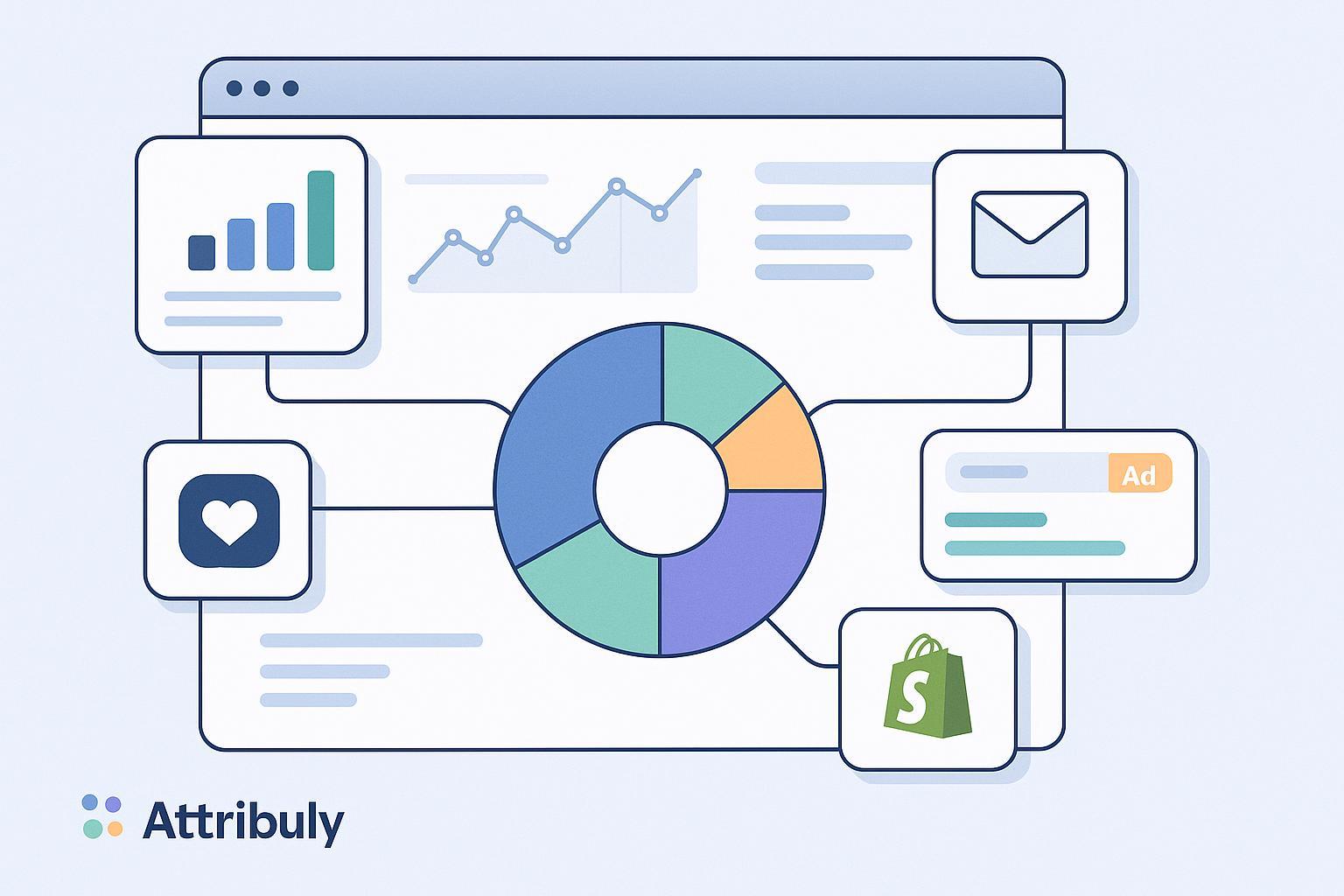Linear Attribution Model: The Ultimate Guide for Shopify & E-commerce Marketers (with Attribuly Workflow)

Picture This: The Omnichannel E-commerce Puzzle
You just invested in TikTok ads, spun up Klaviyo email campaigns, ran Google search ads, and watched Shopify bring in site visits. But when a customer finally buys—who gets the credit?
If you’ve scratched your head over where to attribute ROI or how much to budget for each marketing channel, congratulations: You’re wrestling with the attribution dilemma e-commerce brands face every day. The solution? Understanding attribution models, starting with one of the simplest—and most transparent—the Linear Attribution Model.
What is the Linear Attribution Model?
Definition: The Linear Attribution Model is a multi-touch framework that equally credits every channel and interaction along a customer’s path to purchase. If your conversion journey has four touchpoints, each gets 25% of the credit—no favorites!
Formula:
Credit per touchpoint = 1 / (number of touchpoints in journey)
Distinction:
- NOT first- or last-click: Unlike models that reward only the first or final touch, linear attribution spreads the love evenly—great for brands wanting to value all contributions along the journey.
Learn more: Usermaven’s intro to Linear Attribution
Shopify Example: See Linear Attribution in Action
Conversion Path:
Imagine a $200 order with this real-world, Shopify-powered journey:
- TikTok Ad (brand discovery)
- Klaviyo Email (retargeted offer)
- Google Search Ad (intent-driven)
- Direct Visit to your Shopify store (final purchase)
Linear Attribution Model Calculation:
| Touchpoint | Credit (%) | Credit ($) |
|---|---|---|
| TikTok Ad | 25% | $50 |
| Klaviyo Email | 25% | $50 |
| Google Search Ad | 25% | $50 |
| Direct Visit | 25% | $50 |
Every channel gets equal recognition for influencing the sale.
See more examples: EasyInsights’ Linear Attribution In Marketing
Why Choose Linear Attribution for Your DTC Brand?
Advantages:
- Easy to understand and implement—no data science degree needed.
- Inclusive: Every channel in your e-commerce stack (social, email, paid ads, referral, etc.) gets credit, making it ideal for omni-channel and DTC brands.
- Avoids over-valuing just first or last touches, highlighting the full marketing journey rather than single-channel wins.
When Linear Attribution Works Best:
- Short to medium sales cycles with many smaller touchpoints (think: impulse buys, frequent promos, or influencer-driven discovery).
- Brands testing new channels, wanting to ensure every effort is tracked and valued.
- When your marketing channels genuinely support each other rather than compete.
Honest Limitations Marketers Must Know
But here’s the full picture—linear isn’t perfect for every store or campaign.
Potential Pitfalls:
- Equal credit isn’t always fair: If a viral TikTok drives 80% of the intent, giving it the same as a minor email nudge could distort spend decisions.
- Ignores influence: Fails to capture priming or high-impact steps, which can matter for B2B, influencer collaborations, or retargeting-heavy brands.
- Privacy & Tracking Gaps: Cookieless environments or blocked tracking pixels can make it hard to identify all touchpoints, slightly weakening linear’s utility.
More on attribution challenges: NoGood’s 2024 Attribution Model Guide
Setting Up Linear Attribution in Shopify (& Attribuly): Step-by-Step
If you’re using Shopify, the platform’s basic analytics offer only limited (last-click bias) attribution. Modern brands turn to third-party analytics like Attribuly for flexible, privacy-ready multi-touch modeling.
How to Apply the Linear Model with Attribuly
- Install Attribuly for Shopify from the Shopify App Store.
- Sync Your Channels: Connect TikTok, Meta, Google Ads, Klaviyo, SMS, direct traffic—Attribuly pulls data server-side for accuracy.
- Choose Attribution Model: In Attribuly’s dashboard, select “Linear Attribution” in report settings.
- Review the Multi-Channel Journey: See each customer’s path across all integrated touchpoints. Attribuly’s dashboard visualizes the linear credit split (bar or pie charts per channel, order, or campaign).
- Interpret & Optimize: Use the equally split values to:
- Justify continued spend across all effective channels
- Identify underperformers by their share of conversions vs. spend
- Power advanced segmentation: see if certain audiences engage more with one channel
- Leverage Privacy-First Tracking: Attribuly’s server-side and AI-powered tracking means you don’t lose visibility when third-party cookies are blocked—a critical edge for DTC/Shopify brands in 2025.
Attribuly brings multi-touch attribution to Shopify with no code, automating segmentation, and enabling easy channel-level optimization—even as privacy rules evolve.
Attribuly: E-commerce Attribution Platform
Linear vs. Other Attribution Models: Quick Comparison Table
| Model | How Credit is Assigned | When to Use | Caveats |
|---|---|---|---|
| Linear | Equally across all touchpoints | Omni-channel/DTC | May over/under value steps |
| First-Click | 100% to first touch | Brand awareness focus | Ignores converting touch |
| Last-Click | 100% to last touch | Quick impulsive buys | Ignores earlier actions |
| U-shaped | 40/20/40 (first, mid, last) | Lifecycle marketing | Middle steps get less credit |
| Time Decay | More credit to recent touches | Long sales cycles | Misses early-intent builders |
| Data-Driven | Uses AI/modeling to assign shares | Large, data-rich | Needs technical resources |
Attribuly users can flexibly compare and A/B test between these models to see which fits their brand’s actual customer behavior—try running both linear and data-driven simultaneously for richer insight!
Deep dive: Improvado’s Attribution Model Guide
The 2025 Edge: Server-Side Tracking, AI, and Privacy Trends
As browser privacy and iOS updates make tracking harder, most e-commerce brands are back to basics—but with smarter tools. Linear remains the “clear baseline” model:
- Attribuly’s server-side tracking ensures your attribution is still accurate, even when browser cookies fail.
- AI-powered assistance—like Attribuly’s analytics assistant—can suggest improvements or spot abnormal channel trends in your linear split.
- Identity resolution: Attribuly can help “stitch” user journeys together, making linear attribution valid even in cookieless or cross-device environments.
Read more: Shopify’s 2024 Attribution Guide | Northbeam’s Incrementality Analysis
Pro Tips: Is Linear Attribution Right for Your E-commerce Store?
- Best fit when: You’ve got active, omnichannel campaigns and want a fair, transparency-first way to justify channel investments.
- Rethink linear if: Your sales cycle is long and uneven, or a few channels are clear revenue drivers (e.g., viral TikTok + sluggish email list).
- Always test!: In Attribuly, segment your data by product, campaign, or audience to see if equal credit allocation matches real business results. Use built-in comparison tools and reports.
- Stay privacy-ready: Ensure your tracking is server-side and first-party where possible—linear only works as well as your ability to see the journey.
Bottom Line: Putting Linear Attribution to Work in 2025
The Linear Attribution Model is the transparency-driven starting point for modern Shopify and DTC brands—but it reaches full potential only when paired with the right analytics infrastructure.
Tools like Attribuly make it easy for anyone to implement, test, and optimize linear attribution, even as privacy, tracking tech, and ecommerce complexity continue to evolve. Linear is not the “forever” solution, but it is the clearest, fairest foundation for budget allocation, channel testing, and growth strategy in the real world of e-commerce marketing.
Ready to optimize your omnichannel marketing and see the whole story—not just the first or last click? Explore Attribuly and get a 360° view of your Shopify sales in 2025 and beyond.
References:
